|
September 1932 Radio News
 [Table
of Contents] [Table
of Contents]
Wax nostalgic about and learn from the history of early
electronics. See articles from
Radio & Television News, published 1919-1959. All copyrights hereby
acknowledged.
|
Being that we are entering
the forest fire season with the onset of summer, this story from a 1932
edition of Radio News magazine is an appropriate recognition of the sacrifice
offered by firefighters who battle the destructive conflagrations.
Firefighters of all specialties have relied on radio communications nearly since
its inception, and particularly once battery-powered versions became available for
portability. It is hard to imagine a time when such a convenience - even a necessity
- was not part of the standard firefighting outfit. Nowadays the radios are compact
and clip onto a shoulder lapel, but in 1932 the vacuum tubes, large transformers
and batteries meant even a primitive radio was in the form of a harness-mounted
manpack
radio (a word not yet coined at the time). The portable half-wave dipole antenna
in the picture looks almost exactly like ones I have seen advertised in
contemporary issues of
QST magazine.
Radio Fights Forest Fire

By George A. Duthie*
The forest Ranger up to this time had to rely upon primitive communication methods
in fighting great fires in our National forests. He has hit the trail to carry word
of a conflagration either by horse or afoot. But now radio comes to the rescue with
two portable transmitter-receivers that contact headquarters within a few seconds
bringing necessary help and equipment in short order
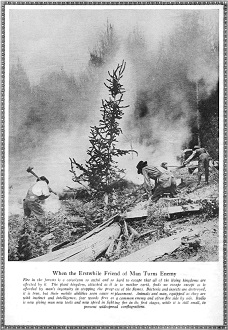
When the Erstwhile Friend of Man Turns Enemy
Fire in the forests is a cataclysm so awful and so hard to escape that all of
the living kingdoms are affected by it. The plant kingdom, attached as it is to
mother earth, finds no escape except as is afforded by man's ingenuity in stopping
the progress of the flames. Bacteria and insects are destroyed, it is true, but
their mobile abilities soon cause replacement. Animals and man, equipped as they
are with instinct and intelligence, fear woods fires as a common enemy and often
flee side by side. Radio is now giving man new tools and new speed in fighting fire
in its first stages, while it is still small, to prevent widespread conflagrations.
Forest Service Photos
Portable radio receiver-transmitters for emergency communication in the national
forests is a recent achievement of the U. S. Forest Service. It is an achievement
hailed with enthusiasm by forest officers. Since the day when the radio telephone
was announced forest rangers have dreamed daydreams of the time when a ranger on
leaving for a trip to the back country, would slip a radiophone into his pack, along
with his grub, and be able to report back to headquarters from the deep woods or
from beyond the high ranges. "An impractical, futile dream," said experts who were
appealed to for help to solve the problem. But the ranger "amateurs" unfettered
by knowledge of radio engineering that recognized this futility, substituted enthusiasm
for learning, and trial-and-error experiments for fundamental research, to achieve
the impossible. The dream has now come true. Its final achievement was marked by
a recent order for the construction of 105 portable and 27 semi-portable radio sets
of a special Forest Service design. It is the first step toward equipping the field
force with this long-sought solution for its emergency communication problems. It
is the culmination of 14 years of research on radio transmitter-receiver sets that
can be carried about in the forests and set up at will for temporary emergency service.
Although both sets are portable radio transmitter-receivers, the smaller instrument
is referred to as the "portable" because it is so light that it can be carried about
in a ranger's back-pack. It weighs only 10 3/4 pounds including batteries and antenna
and is literally a hand radio set which the forester can carry right along with
him as he works (See Figure 1). For the sake of lightness the phone transmitter
is dispensed with and the instrument transmits code only - but it receives voice!
The larger set is called "semi-portable" to distinguish it from the portable. It
is a radio-phone (receiving and transmitting) handling voice as well as code. It
weighs about 60 pounds and may readily be transported any place where a pack-horse
can go.
In the forests the communication problem is present on almost every job. Whether
it is fire patrol or fire suppression, building roads or trails cruising timber,
rescuing lost persons or inspecting range, there is always need for communication.
The work is spread over thousands of square miles of rough timbered territory and
the efficiency and speed with which it is done is directly affected by the efficiency
of the communication system in quite the same way that field operation of an army
depends upon its communication service. Between points of permanent activity, such
as ranger headquarters and lookout stations, telephone lines have already been built.
There are 40,000 miles of government-owned lines in the forests, and approximately
100,000 miles of commercial and private lines, all of which are available for official
use and yet less than 20 percent. of the territory lies within convenient reach
of a telephone line. There are 200,000 square miles of territory without communication
service except by messenger or, temporarily, by stringing insulated emergency wire.
The use of the latter type of communication has been confined principally to
large fires where it has rendered valuable aid, but it is not satisfactory because
it is slow, expensive and generally inadequate. A crew of men will toil for days
to reach the fire camp with an emergency line and the pressing need for it is sometimes
past before it is completed. It is costly because it is difficult to lay down and
maintain, and frequently the wire is not worth the cost of salvage after the emergency
is over. It is inadequate because it furnishes connections only to the supply base.
A wire line cannot be maintained to the rapidly changing fire front where sweating
crews are waging a real battle. It is here that the communication need is most acute,
for the fire fighters may be frantically calling for help but their message will
speed no faster than a runner can travel. The work of the various crews attacking
the fire on several sectors must be correlated, but the officer in charge can receive
his reports and send out instructions only by a messenger who may take an hour (or
many hours) to reach his objective.
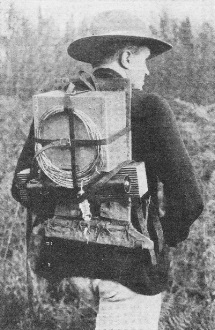
The Ranger's Portable Radio Pack
Figure 1 - Special forest service radio pack, weight ten pounds,
range ten miles
Minutes Count at a Fire
The radio solves this problem, for it will move right along with the crews. It
takes but a few minutes to set up the instruments and its message reports the situation
to headquarters at the instant - not the situation as it was an hour or five or
ten hours ago. I have timed a forest officer who, without hurry, unpacked a portable
set, hung up his antenna between two trees, and established communication with a
distant station in twelve minutes. In fire suppression work minutes count and that
is why the radiophone is regarded as an achievement of great importance in forest
protection. The patrolman or the "smoke chaser" hunting incipient fires or the crew
boss on the fire line may now carry his communication with him and contact headquarters
at will (See Figure 2).
How often do small fires become raging conflagrations during the interval while
re-enforcements are being summoned? Perhaps a margin of thirty minutes in arrival
time would have been sufficient to stop the fire in its first run. The portable
set will give the forest officers the benefit of that margin.
Radio will not, however, replace the telephone lines for regular service between
permanent stations. It will supplement the wire system and provide temporary emergency
communication for 80 percent. of the forest territory that is out-of-reach of the
wire lines. The equipment designed by the Forest Service for its work consists of
two short-wave sets; a 3-tube portable for the patrolman's pack, light, compact
and sturdy, which transmits code and receives voice; and a 6-tube semi-portable
set which can be readily transported by pack horse or automobile and which transmits
and receives either code or voice.
The outstanding features of the portable set are its light weight; its compactness;
its simple, rugged construction; and its low cost. These four features, together
with dependable service under the peculiar atmospheric conditions encountered in
forests, comprise the essential requirements that the set had to meet before it
could be adopted. Its power plant consists of a single 140-volt B battery and an
A battery of two flashlight cells which have a life of seven hours. The power of
the transmitter is too small to be measured, but its C.W. range is from 10 to 15
miles - which is enough for its purpose. Exclusive of B battery and antenna, the
entire equipment is contained in an aluminum box 6 by 8 by 9 inches. It weighs but
a trifle more than 10 pounds and can be fabricated for $50.
Semi-portable Ranger Set

Figure 2 - Smoke Chaser with Portable Set
This ranger is recording back to field headquarters an incipient
fire by means of the portable set for field use
The semi-portable radiophone (See Figure 3) weighs 60 pounds and has a range
of 10 miles for voice and 20 miles for code. Its power consists of two 200-volt
B batteries and an A battery of three No.6 dry-cells. It is constructed with the
same rugged simplicity as the portable set. While it is too heavy for a man to pack
far over mountain trails, it will stand packing on a horse or by automobile over
rough roads.
The scheme of use for the two sets is to place the semi-portable at the lookout
station, the fire camp or construction camp or any other field job when the short
period of occupancy of the camp and the distance from a telephone line renders wire
communication unavailable. The portables will be carried by the field-going men
who are traveling on foot or by saddle horse. At the lookout station, the radiophone
will act as central station to which the "smoke chasers," who are dispatched to
investigate smokes, will report back with the portable C.W. sets. On large fires,
the crew bosses and patrolmen will carry the portables on the fire line for reporting
to the central camp where a dispatcher will be constantly on the air with a semi-portable
radiophone. A contemplated development for camp set-up is an amplified receiver
which will pick up the signals from the field sets and make them audible without
keeping the dispatcher with his ears glued to the headphones.
The history of the development of this equipment, like that of most new equipment,
has been one of long research, many discouragements, threatened abandonment and
a slow breaking down of the main obstacles and final success in a climax of feverish
enthusiasm. The first attempt to use radio in forest work was made immediately following
the World War with long-wave equipment. It was a complete failure but it served
to discover some of the special problems of radio transmission peculiar to the conditions
in the forests. These problems, for some years, appeared to be insurmountable obstacles
the adaptation of radio to forest communication.
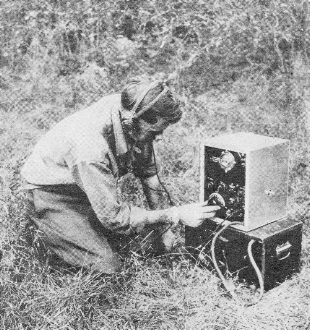
Set-up at Field Headquarters
Figure 3 - This semi-portable radiophone can be carried by motor
or pack horse and set-up in a safe location near the fire to contact rangers on
the fire line.
The Chief Obstacles Were:
1. The absorption of radio energy by the green timber, which to overcome would,
it seemed, require much more power than could be provided in a portable set. 2.
The shadow effects of rough topography. Under high mountains there might be "dead
spots" from which low-power radio signals could not emerge. 3. The deadening effect
of static and fading in the mountainous country, an effect that varies for different
wavelengths and for different periods of the day. 4. The difficulty of erecting
long antennas in the forest where the thicket of undergrowth and swaying branches
of trees would interfere. 5. The mechanical difficulty of constructing a set with
a combination of extremely light weight and the sturdy construction which is necessary
to withstand the hazards of transportation in a wilderness country. 6. Simplicity
of design which will obviate delicate adjustments and tuning so that the apparatus
can be operated by inexperienced and unskilled men.
It would be a simple matter to build radio sets that would overcome any one of
these obstacles, but to successfully meet all of them in combination presented a
discouraging, yes even hopeless, problem for many years.
Following the failure of the first attempt to use radio, nothing more was done
for several years save that some of the more radio-minded members of the service
kept the idea simmering until in 1927, Dwight L. Beatty, an inspector, made some
interesting demonstrations with a small short-wave "bread-board" set which resulted
in his detachment from other duties and his full-time assignment to the radio problem.
Beatty first canvassed the field of commercial sets, especially airplane radio,
but found nothing that would meet the forest requirements. Radio engineers and experts
were interviewed, but they offered no suggestions more than to say that the problem
opened up a field of research in which they could see little opportunity for fruitful
work. It became obvious, therefore, that if radio-in-the-woods was to become possible,
it must come through amateur experimentation.
So Beatty set to work. At the outset, his purpose was to discover the effect
of absorption of radio energy by green timber and the nature of the interference
encountered in the shadow of rough topography. He found that the loss in signal
strength, in timber as compared to an open setting, ranged as high as 35 percent.
He also discovered that the shadow effect and fading in the mountains varied in
wide limits for different wavelengths and that these variations changed during different
periods of the day. For example a 91-meter signal at noon might be completely smothered
but after 4 o'clock it picked up in volume while from the same station a 55-meter
signal which was strong, throughout the day, faded away at night. He found also
that some types of equipment were more sensitive to these effects than others, which
led him into extensive tests of different combinations of parts and hook-ups. He
worked diligently for three years, endlessly building sets, testing them under field
conditions, tearing them down, rearranging and reconstructing, always searching
for improved equipment that would improve efficiency and better provide the specified
qualities of lightness, compactness, strong construction, efficiency of performance
under forest conditions, simple design and low cost. Only standard parts were used
so that there is nothing new about the equipment except its design and assembly.
In each alteration of design greater simplicity was sought. Every dispensable part
was eliminated to reduce weight.
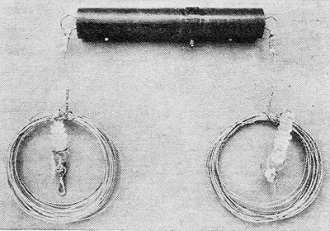
The Power-Feed Antenna
Figure 4 - This antenna was developed for the special use of
the forest service radio-phone.
Bottom View of the Two Ranger Units
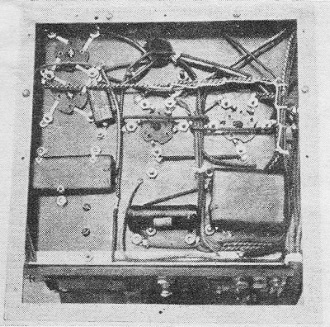
Figure 5a - The underneath view of the sub-panel of the semi-portable
transmitter-receiver.
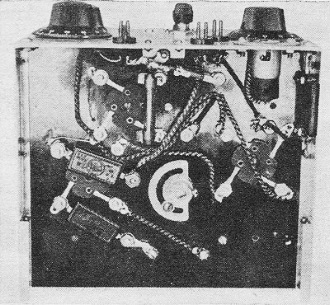
Figure 5b - The same view of the portable unit which may be carried
on the ranger's back
By the summer of 1930, Beatty had developed two sets: a semi-portable radio-phone
weighing approximately 80 pounds (including batteries and antenna) and a portable
set weighing less than 20 pounds. The antennas employed with both types were the
same. It was a counterpoise system consisting of an antenna wire stretched approximately
15 feet from the ground between two light masts and a counterpoise wire at 3 1/2
feet, stretched parallel to the antenna wire. The length of the system varied from
73 to 90 meters, according to the frequency in use.
Both sets were given extensive field tests in 1930 in the Columbia forest in
southern Washington. Seven of the portables were placed in service with road and
trail crews and fire patrolmen, and were used throughout the summer. Two of them
were used at the Dog Mountain fire, where a large number of messages were exchanged
during the course of the fire. Although these sets were used by men inexperienced
in radio and without training in the use of code, the records of the use of the
seven instruments showed better than 94 percent successful performance. The 6 percent
failures were due, almost entirely, to weather conditions.
In spite of this good record there were still many problems to be worked out
before the equipment could be voted a success under all conditions. The bugbear
of absorption and shadows had been largely overcome, but the equipment was too heavy
and the aerial too cumbersome. Therefore, when Beatty dropped the work in early
1931 there was grave danger that it would be discontinued. It was rescued from the
discard by F. V. Horton, assistant regional forester of Portland, who put A. Gael
Simson in charge of the work.
Simson was employed in forest research but he was an amateur radio enthusiast,
having served as a radio operator in the Navy during the World War. He was given
two assistants, Harold K. Lawson, a young logging engineer who was employed on timber
sales work and road building, and W. F. Squibb, a student of electrical engineering
at Washington State College, who accepted short-term summer employment as a ranger
guard. All of these men are amateur radio fans. They took up the job where Beatty
left it and tackled the unsolved problems with that intense enthusiasm that only
an amateur knows. Three months after they started work, I happened in at headquarters
one Sunday morning and finding the whole crew hard at work I remarked to Simson:
"Your assistants seem to be pretty much interested in their job." "To a fault,"
he replied tersely, "Lawson, there, is a logging engineer. He thinks the right time
to begin the day is 7 a.m., but Squib is a student; he likes to work at night and
is ready to call it a day about midnight, and between the two they work me a mighty
long shift." So the testing, experimenting, and rebuilding went on, almost feverishly,
throughout the summer. Both sets shriveled in size and weight and increased in reliable
performance. Perhaps the most outstanding improvement, however, was in the antenna.
The counterpoise system was unsatisfactory because it is clumsy and unhandy to
erect. The two wires must be taut, parallel and reasonably level. On rough ground
or in dense undergrowth, finding a suitable place to erect it frequently presented
a serious problem. An opening may be readily found where a single antenna wire can
be stretched where it is quite impossible to find one where two wires could be stretched
12 feet apart in the clear. It was, therefore, decided to make a special effort
to develop a single-wire system and the result is a power-feed antenna of very simple
design (See Figure 4). The length of the antenna is made to correspond to the frequency
of the transmitter. A loading coil, fitted with a terminal attachment for the feeder
wire, is inserted at the correct point to give the best results. This point has
been found to be about 14 percent. "off-center." The coil reduced the length of
the antenna to about 70 feet, which greatly simplifies its erection. Since the point
of attachment of the feeder wire is definitely fixed by the terminal post on the
coil, no particular care in erecting the power-feed antenna is necessary, excepting
to be sure it is in-the-clear of branches or other interference. It has the additional
advantage of being several pounds lighter than the counterpoise system, which is
an important contribution to the success of the project.
The innumerable field tests of the past year have brought a great deal of new
information about the selection of a site for the set-up. It was found, for instance,
that a shift of 200 yards from the base of an overshadowing ridge may increase the
strength of the signals as much as two points in a scale of ten, of which seven
points represent the normal degree of loudness that the receiving operator desires
from a headphone clamped to his ears. Another subject of inquiry was how readily
inexperienced men could be expected to become proficient in the use of the C.W.
portable set. Many of the men who may have occasion to use it will be temporary
laborers, for whom no preliminary training in sending code is possible. It is really
remarkable how quickly untrained men, who may never before have seen a telegraph
key used, can pick up the use of the code. A monitor is built into the receiver
which permits the operator to hear his own signals. This steadies his sending and
provides a constant check on its quality. With a surprisingly small amount of practice
he can send intelligible code signals with the tiny telegraph key. As a final demonstration
test, a young laborer employed on trail construction was given about 30 minutes
coaching and was instructed to send a dictated message. In 46 minutes he set up
the radio, coded the message, sent it to a distant station, had it repeated back
to him by voice, and packed up the radio ready for transportation. This demonstration
silenced all doubts whether the rank and file of officers and temporary employees
would or would not be able to use the C.W. sets without long preliminary training.
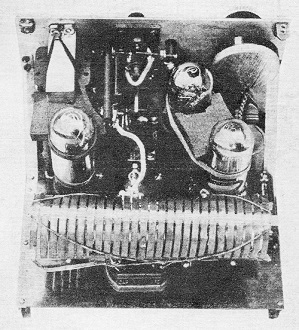
Inside the Portable
Figure 6 - This inner view shows the details of the c.w. transmitter-receiver
illustrating compact arrangement.
If light weight is the first essential, sturdy construction is a second requisite
of almost equal importance. The vibrations, knocks, and jolts of transportation
by truck, pack-horse or man-pack would quickly disable the delicate meters which
are usually considered indispensable in a radio transmitter. All delicate parts
and fragile wiring had to be eliminated to insure dependable performance of the
equipment when it reaches the field. It was found possible to dispense with all
meters (except a small voltmeter which can be successfully cushioned in sponge rubber).
The simple arrangement of the parts, to reduce wiring and strength of all connections,
were worked out with great care (See Figure 5), and the tubes are set in spring
sockets and cushioned with sponge rubber (See Figure 6) so that they need not be
removed during transportation. Both sets have been subjected to every kind of stress
they may meet with in field use and have stood up under the roughest kind of treatment.
Finally the designers decided to give the semi-portable radiophone an accident
test, just to see how much it would stand and where failure might first be expected.
Four of the six tubes were tied to their sockets with rubber, the remaining tubes
were left free. The set was then dropped 14 feet to the ground! The jolt caused
the two free tubes to jump from their sockets and to break. The broken glass was
shaken out of the set, the two broken tubes replaced and it was put "on-the-air"
without further adjustment and a conversation carried on with a station 60 miles
away. The sets have certainly been built for rough going!
The experimental stage is now completed. Every conceivable test for weaknesses
that might develop has been made and as weak points have developed changes were
made to remedy them. Radio is now ready for the field, the forests, and a thousand
ranger officers are reaching for it. Approximately 150 sets will be available this
year, and these will be issued to a few forests where the need for them seems most
urgent and where good opportunity exists for exacting field tryouts. It is to be
expected that some failures may develop, for the sets will be used in every kind
of climatic situation from the humid forests of northern Washington to dry deserts
of Arizona and California, from sea level to the timberline country of the Continental
Divide, in heat and cold and from mountain top to the bottom of deep canyons. Some
situations may be found where special equipment or change of design will be necessary,
but the versatility they have already displayed in experimental tests gives confidence
in their adaptability to almost any situation. Long before sufficient equipment
to supply all of the forests can be had, there will be opportunity to discover any
peculiar situations where special adaptations will be necessary.
A problem which can be foreseen, but upon which no work has as yet been done,
is regulation of traffic in the channels assigned to the Forest Service. When 147
forests are equipped with radiophones and each forest has several central-camp stations
receiving reports from several individuals using portable sets, it can be foreseen
that, without regulation, there might be chaos. The very-low power and range of
the instruments will help to hold this situation in check to some extent, but some
additional regulation will doubtless be necessary so that all the men will not try
to talk at once.
* Forest Service, U.S. Department of Agriculture.
Posted June 28, 2023
(updated from original post
on 7/4/2014)
|


















